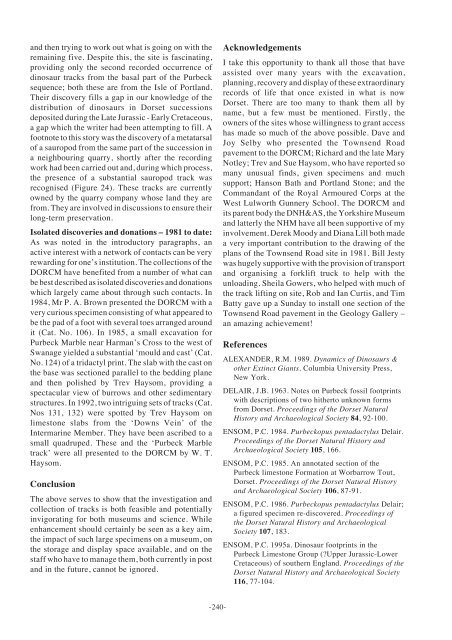Continental trace fossils and museum exhibits - Geological Curators ...
Continental trace fossils and museum exhibits - Geological Curators ...
Continental trace fossils and museum exhibits - Geological Curators ...
You also want an ePaper? Increase the reach of your titles
YUMPU automatically turns print PDFs into web optimized ePapers that Google loves.
<strong>and</strong> then trying to work out what is going on with theremaining five. Despite this, the site is fascinating,providing only the second recorded occurrence ofdinosaur tracks from the basal part of the Purbecksequence; both these are from the Isle of Portl<strong>and</strong>.Their discovery fills a gap in our knowledge of thedistribution of dinosaurs in Dorset successionsdeposited during the Late Jurassic - Early Cretaceous,a gap which the writer had been attempting to fill. Afootnote to this story was the discovery of a metatarsalof a sauropod from the same part of the succession ina neighbouring quarry, shortly after the recordingwork had been carried out <strong>and</strong>, during which process,the presence of a substantial sauropod track wasrecognised (Figure 24). These tracks are currentlyowned by the quarry company whose l<strong>and</strong> they arefrom. They are involved in discussions to ensure theirlong-term preservation.Isolated discoveries <strong>and</strong> donations – 1981 to date:As was noted in the introductory paragraphs, anactive interest with a network of contacts can be veryrewarding for one’s institution. The collections of theDORCM have benefited from a number of what canbe best described as isolated discoveries <strong>and</strong> donationswhich largely came about through such contacts. In1984, Mr P. A. Brown presented the DORCM with avery curious specimen consisting of what appeared tobe the pad of a foot with several toes arranged aroundit (Cat. No. 106). In 1985, a small excavation forPurbeck Marble near Harman’s Cross to the west ofSwanage yielded a substantial ‘mould <strong>and</strong> cast’ (Cat.No. 124) of a tridactyl print. The slab with the cast onthe base was sectioned parallel to the bedding plane<strong>and</strong> then polished by Trev Haysom, providing aspectacular view of burrows <strong>and</strong> other sedimentarystructures. In 1992, two intriguing sets of tracks (Cat.Nos 131, 132) were spotted by Trev Haysom onlimestone slabs from the ‘Downs Vein’ of theIntermarine Member. They have been ascribed to asmall quadruped. These <strong>and</strong> the ‘Purbeck Marbletrack’ were all presented to the DORCM by W. T.Haysom.ConclusionThe above serves to show that the investigation <strong>and</strong>collection of tracks is both feasible <strong>and</strong> potentiallyinvigorating for both <strong>museum</strong>s <strong>and</strong> science. Whileenhancement should certainly be seen as a key aim,the impact of such large specimens on a <strong>museum</strong>, onthe storage <strong>and</strong> display space available, <strong>and</strong> on thestaff who have to manage them, both currently in post<strong>and</strong> in the future, cannot be ignored.AcknowledgementsI take this opportunity to thank all those that haveassisted over many years with the excavation,planning, recovery <strong>and</strong> display of these extraordinaryrecords of life that once existed in what is nowDorset. There are too many to thank them all byname, but a few must be mentioned. Firstly, theowners of the sites whose willingness to grant accesshas made so much of the above possible. Dave <strong>and</strong>Joy Selby who presented the Townsend Roadpavement to the DORCM; Richard <strong>and</strong> the late MaryNotley; Trev <strong>and</strong> Sue Haysom, who have reported somany unusual finds, given specimens <strong>and</strong> muchsupport; Hanson Bath <strong>and</strong> Portl<strong>and</strong> Stone; <strong>and</strong> theComm<strong>and</strong>ant of the Royal Armoured Corps at theWest Lulworth Gunnery School. The DORCM <strong>and</strong>its parent body the DNH&AS, the Yorkshire Museum<strong>and</strong> latterly the NHM have all been supportive of myinvolvement. Derek Moody <strong>and</strong> Diana Lill both madea very important contribution to the drawing of theplans of the Townsend Road site in 1981. Bill Jestywas hugely supportive with the provision of transport<strong>and</strong> organising a forklift truck to help with theunloading. Sheila Gowers, who helped with much ofthe track lifting on site, Rob <strong>and</strong> Ian Curtis, <strong>and</strong> TimBatty gave up a Sunday to install one section of theTownsend Road pavement in the Geology Gallery –an amazing achievement!ReferencesALEXANDER, R.M. 1989. Dynamics of Dinosaurs &other Extinct Giants. Columbia University Press,New York.DELAIR, J.B. 1963. Notes on Purbeck fossil footprintswith descriptions of two hitherto unknown formsfrom Dorset. Proceedings of the Dorset NaturalHistory <strong>and</strong> Archaeological Society 84, 92-100.ENSOM, P.C. 1984. Purbeckopus pentadactylus Delair.Proceedings of the Dorset Natural History <strong>and</strong>Archaeological Society 105, 166.ENSOM, P.C. 1985. An annotated section of thePurbeck limestone Formation at Worbarrow Tout,Dorset. Proceedings of the Dorset Natural History<strong>and</strong> Archaeological Society 106, 87-91.ENSOM, P.C. 1986. Purbeckopus pentadactylus Delair;a figured specimen re-discovered. Proceedings ofthe Dorset Natural History <strong>and</strong> ArchaeologicalSociety 107, 183.ENSOM, P.C. 1995a. Dinosaur footprints in thePurbeck Limestone Group (?Upper Jurassic-LowerCretaceous) of southern Engl<strong>and</strong>. Proceedings of theDorset Natural History <strong>and</strong> Archaeological Society116, 77-104.-240-
















